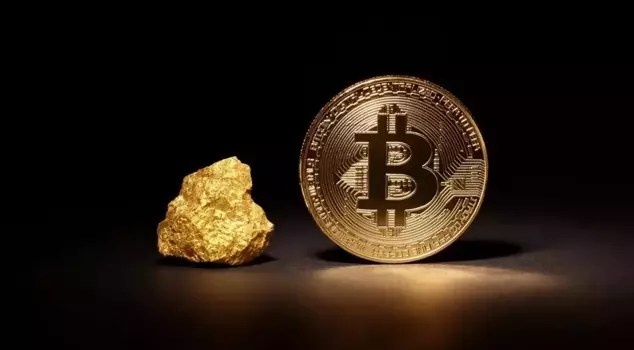
10.04.2025 21:02
When volatility begins in the markets, investors have traditionally sought refuge in the safe haven of gold. However, Bitcoin has increasingly emerged as a digital alternative in recent years. By the time we reach 2025, the comparison between these two assets will no longer be just theoretical; it will be lived within economic reality. So, which will be the best investment in 2025? Bitcoin or gold?
```html
Bitcoin and Gold: Key Differences
Both aim to preserve purchasing power but in completely different ways. One is just a digital code; the other is a physical precious metal. Therefore, it is important to understand how they work to determine which one is more suitable for your portfolio.
Bitcoin: Digital Value Storage Tool
Bitcoin is a blockchain-based digital currency that is not tied to any central authority. Its value is based on investor confidence, widespread usage, and its limited supply. The total supply of Bitcoin is capped at twenty-one million, and its production rate is regularly slowed down by events known as "halving."
Bitcoin does not offer dividends or interest; profits are only realized through price appreciation. However, due to its high volatility, it can sometimes behave like a risky asset, similar to technology stocks.
In recent years, Bitcoin has experienced significant ups and downs. It fell from around sixty-five thousand dollars in November 2021 to sixteen thousand dollars in November 2022. However, by the end of 2023, it rebounded to reach thirty-four thousand dollars. Bitcoin's trading volume is high on major exchanges, but the market still has a fragmented structure. It is gaining popularity among both individual and institutional investors.
Gold: Physical and Safe
Gold is an asset that has preserved its value for thousands of years. It is not a debt or obligation of anyone; it is safe due to its physical structure and rarity. Central banks have increased their gold purchases in recent years to diversify their foreign exchange reserves.
Gold is also used in areas such as jewelry and electronics, but the primary determinant of its price is investment and savings demand. Like Bitcoin, gold does not provide direct returns. Returns are generated solely through price changes.
The way it is traded in the market has become quite accessible through ETFs and futures. Its volatility is low, and it tends to shine during times of crisis. However, during stable periods, its returns may be limited.
Price Trends in 2024–2025
Over the past two years, both Bitcoin and gold have exhibited strong price movements. During this period, inflation expectations, geopolitical developments, and market liquidity played significant roles.
Bitcoin: Volatile but Resilient
Bitcoin started at around sixteen thousand dollars at the beginning of 2023 and rose above one hundred thousand dollars by early 2025. Increased liquidity, institutional demand, and spot ETF approvals in the U.S. supported this rise. Bitcoin is no longer just a speculative investment; it has become an alternative for those distancing themselves from the traditional financial system.
In April 2025, U.S. President Donald Trump's announcement of a ten percent import tax on all countries created panic in the markets. Bitcoin dropped by seven and a half percent in one day, falling to eighty-one thousand dollars. On the same day, stocks also experienced significant losses.
Outflows from ETF products indicated a decrease in risk appetite. However, this situation partially recovered within a few days.
Long-Term Outlook: Opportunities and Risks
Bitcoin and gold have very different investment narratives.
Bitcoin: High Risk, High Reward
The core investment narrative of Bitcoin is based on its limited supply and long-term potential. Institutional investors are now taking this asset seriously. Even a small allocation from large players like pension funds and sovereign wealth funds can significantly impact the price.
Second-layer solutions (e.g., Lightning Network) increase transaction speed, while regulated investment vehicles (e.g., ETFs) facilitate access. If currencies continue to lose value globally, Bitcoin may stand out more as "digital gold."
If Bitcoin's price approaches the market value of gold or is recognized as a global reserve asset, it could increase exponentially from its current level. However, this high return potential also comes with high volatility and regulatory risks.
Gold: Safe Haven, Balanced Returns
Gold stands out as a wealth preservation tool in the long term. It performs strongly, especially in scenarios of high inflation or loose monetary policy. Historically, gold has risen when the purchasing power of currencies has declined, as seen in the 1970s.
In recent years, central banks' interest in gold has increased. Countries like China and Russia are diversifying their reserves with gold to reduce dependence on the dollar. Additionally, strong jewelry demand in Asia provides long-term support.
Gold is also important for portfolio diversification: its low correlation with stocks allows it to act as a buffer against market turbulence.
In conclusion, if your goal is long-term growth and to participate in technological innovation, Bitcoin stands out. However, if you are seeking wealth preservation and stability, gold remains a strong alternative. The answer to which asset is better depends on the investor's risk perception, goals, and time horizon.
```